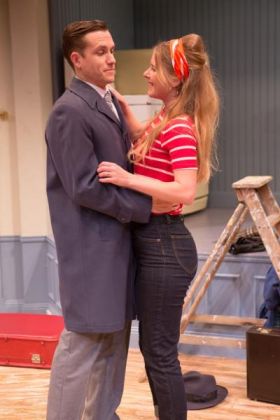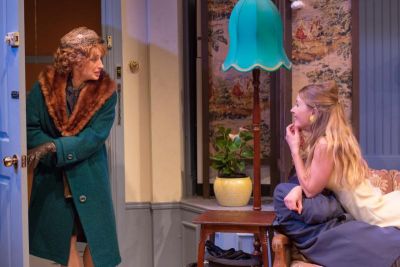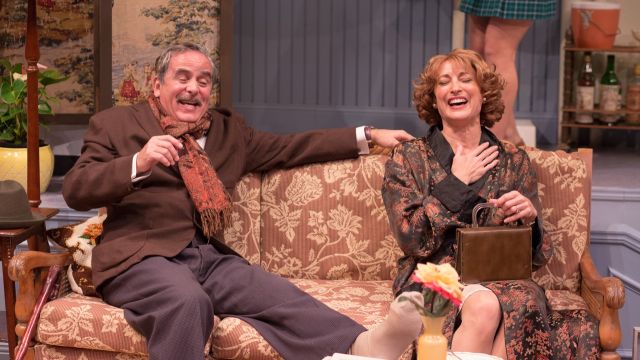Barefoot In The Park
Ensemble Theatre’s classy and tasteful production proves that Neil Simon’s 50 year-old comedy classic is just as relevant as ever. Sure, some parts of the script definitely reflect their late ’60’s time frame but what the show is really about hasn’t dated. Neil Simon’s one–liners and quips still zing and the Cast breath zesty life into these characters.
The show takes place over the first eleven days of a young couple’s marriage. We meet Corie and Paul Bratter on day 7, fresh from their honeymoon and moving into their new home. It’s a small flat. A very small flat. It’s on the top floor and there’s no lift. The neighbours in the block are “interesting”. It’s downtown New York in the middle of Winter and there’s a telephone repairman.
Corie is carefree and impulsive. Paul is the breadwinner lawyer, responsible and ordered. It’s a (seemingly) happy marriage of opposites. He’s the yin to her yang. Mr. Velasco is the middle-aged neighbour who is well-cultured but has a keen eye for the ladies (read: upmarket sleaze). Corie’s Mother – Mrs Banks – can’t help but visit. It becomes clear that Corie’s choice of flat and its location were not haphazard: the tight fit and stairs were meant as deterrents for visiting relatives. We next see these characters on Day 11, after a night out. During this time there are arguments and revelations and realisations and I won’t spoil the fun for you as to how it all pans out.
 Director Mark Kilmurry keeps the action and dialogue moving, with never a dull moment. He also cleverly brings out the truth from the humour.
Director Mark Kilmurry keeps the action and dialogue moving, with never a dull moment. He also cleverly brings out the truth from the humour.
The five-strong cast are a joy to watch. No caricatures here, but all three-dimensional human beings with shades of grey. This includes Jamie Oxenbould’s telephone repairman, used as a device much in the same way Shakespeare used the clown or fool. On stage for a short time, he works the part with great comic timing.
Mia Lethbridge is lovely and believable as Corie Bratter. Ever the ray of sunshine (with some small grey clouds on the horizon), we never stop caring for her or her husband. Speaking of which, Jake Speer’s Paul Bratter is just as lovable. I never felt he was some uncaring stuffed shirt with a trophy wife but a sincere no-nonsense type who is truly in love with Corie.
Georgie Parker’s role as Mrs Banks is a delight. When Ms Parker first enters I thought, “that can’t be Corie’s mother – she looks too young. Maybe it’s her older sister.” However it’s soon clear that momma’s here. And what a wonderful creation. It would be so easy, and wrong, to play this role as a frail, dawdling spinster, or meddling hellbeast. But in Ms Parker’s hands Corie’s Mother is a likable lady with a life of her own. Her concerns for her daughter’s happiness come across as genuine, despite Mrs Banks not always getting the message across in the way Corie would prefer.
My least favourite character was the cad-with-charm, Victor Velasco. However, Daniel Mitchell makes him likable, so that by play end we forgive his rakish ways and accept there’s a heart of gold. The portrayal by Ms Parker and Mr Mitchell of their respective characters is testimony that just because you’re middle aged (and a parent) doesn’t mean that you have to stop having a life.
I did have some problems with the script. When Velasco first meets Corie he does more than just say hi: Corie’s only been married for one week but this middle-aged stranger still hits on her. Instead of kicking him out faster than you can yell “A.V.O.”, Corie finds this all somehow OK. Furthermore Corie seems to think he’d be a great match for her single mother. I suppose there wouldn’t be a play if Velasco wasn’t there. Also, the newlywed’s argument in the second half started out naturally, and progressed naturally. Yet I felt the end result seemed unrealistic and rushed, as though the author stepped in and forced the outcome so as to make a point and further the story. I suppose it was only his second play, and even Shakespeare’s classics have issues.
 Some of the 20-somethings in the audience looked upon this show as a museum piece. We’ve had a whole generation reared on comedy that’s profanity–laden, reliant on gross body functions, innuendo, illegal activity, and catty meta in-jokes. It must have been a surprise to them to find a script with none of that but instead clever one liners and humour that comes from character.
Some of the 20-somethings in the audience looked upon this show as a museum piece. We’ve had a whole generation reared on comedy that’s profanity–laden, reliant on gross body functions, innuendo, illegal activity, and catty meta in-jokes. It must have been a surprise to them to find a script with none of that but instead clever one liners and humour that comes from character.
Special mention to the set design by Alicia Clements: the stage certainly looks like a small apartment in 1960s New York, and the “of-era” props must have been hell to find.
Special thanks to Natasha McNamara as dialect coach: it was a relief hearing the actors speak in real accents, and not as escapees from “Noo Yawk” or “Noo Joyzi”.
Highly recommended.
Peter Novakovich
Photographer: Clare Hawley.
Subscribe to our E-Newsletter, buy our latest print edition or find a Performing Arts book at Book Nook.

